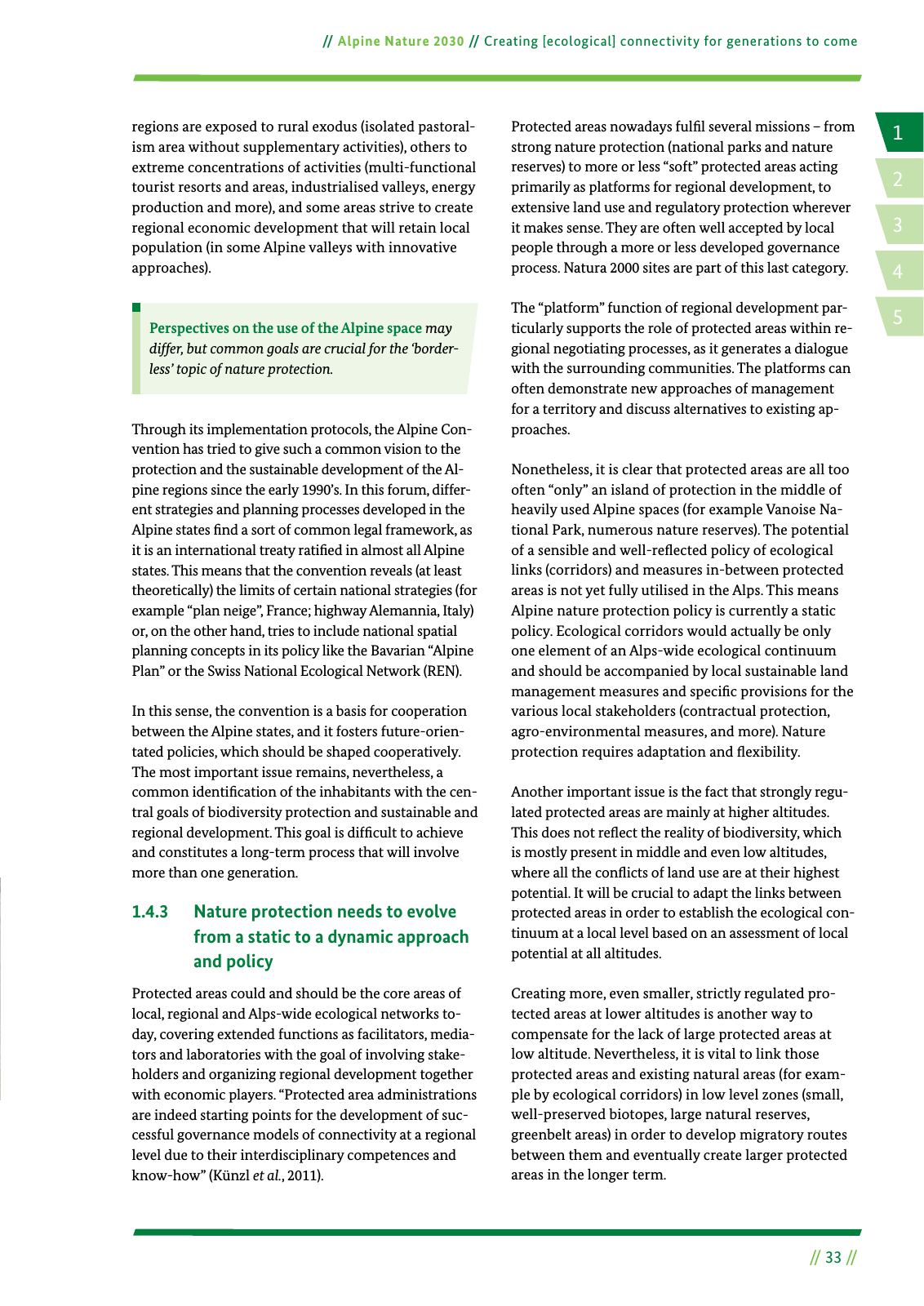14 2 5 3 33 Alpine Nature 2030 Creating ecological connectivity for generations to come regions are exposed to rural exodus isolated pastoral ism area without supplementary activities others to extreme concentrations of activities multi functional tourist resorts and areas industrialised valleys energy production and more and some areas strive to create regional economic development that will retain local population in some Alpine valleys with innovative approaches Perspectives on the use of the Alpine space may differ but common goals are crucial for the border less topic of nature protection Through its implementation protocols the Alpine Con vention has tried to give such a common vision to the protection and the sustainable development of the Al pine regions since the early 1990 s In this forum differ ent strategies and planning processes developed in the Alpine states nd a sort of common legal framework as it is an international treaty rati ed in almost all Alpine states This means that the convention reveals at least theoretically the limits of certain national strategies for example plan neige France highway Alemannia Italy or on the other hand tries to include national spatial planning concepts in its policy like the Bavarian Alpine Plan or the Swiss National Ecological Network REN In this sense the convention is a basis for cooperation between the Alpine states and it fosters future orien tated policies which should be shaped cooperatively The most important issue remains nevertheless a common identi cation of the inhabitants with the cen tral goals of biodiversity protection and sustainable and regional development This goal is dif cult to achieve and constitutes a long term process that will involve more than one generation 1 4 3 Nature protection needs to evolve from a static to a dynamic approach and policy Protected areas could and should be the core areas of local regional and Alps wide ecological networks to day covering extended functions as facilitators media tors and laboratories with the goal of involving stake holders and organizing regional development together with economic players Protected area administrations are indeed starting points for the development of suc cessful governance models of connectivity at a regional level due to their interdisciplinary competences and know how Künzl et al 2011 Protected areas nowadays ful l several missions from strong nature protection national parks and nature reserves to more or less soft protected areas acting primarily as platforms for regional development to extensive land use and regulatory protection wherever it makes sense They are often well accepted by local people through a more or less developed governance process Natura 2000 sites are part of this last category The platform function of regional development par ticularly supports the role of protected areas within re gional negotiating processes as it generates a dialogue with the surrounding communities The platforms can often demonstrate new approaches of management for a territory and discuss alternatives to existing ap proaches Nonetheless it is clear that protected areas are all too often only an island of protection in the middle of heavily used Alpine spaces for example Vanoise Na tional Park numerous nature reserves The potential of a sensible and well re ected policy of ecological links corridors and measures in between protected areas is not yet fully utilised in the Alps This means Alpine nature protection policy is currently a static policy Ecological corridors would actually be only one element of an Alps wide ecological continuum and should be accompanied by local sustainable land management measures and speci c provisions for the various local stakeholders contractual protection agro environmental measures and more Nature protection requires adaptation and exibility Another important issue is the fact that strongly regu lated protected areas are mainly at higher altitudes This does not re ect the reality of biodiversity which is mostly present in middle and even low altitudes where all the con icts of land use are at their highest potential It will be crucial to adapt the links between protected areas in order to establish the ecological con tinuum at a local level based on an assessment of local potential at all altitudes Creating more even smaller strictly regulated pro tected areas at lower altitudes is another way to compensate for the lack of large protected areas at low altitude Nevertheless it is vital to link those protected areas and existing natural areas for exam ple by ecological corridors in low level zones small well preserved biotopes large natural reserves greenbelt areas in order to develop migratory routes between them and eventually create larger protected areas in the longer term

Hinweis: Dies ist eine maschinenlesbare No-Flash Ansicht.
Klicken Sie hier um zur Online-Version zu gelangen.
Klicken Sie hier um zur Online-Version zu gelangen.